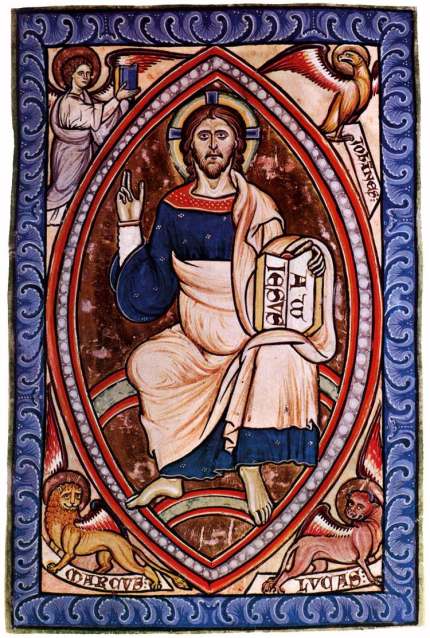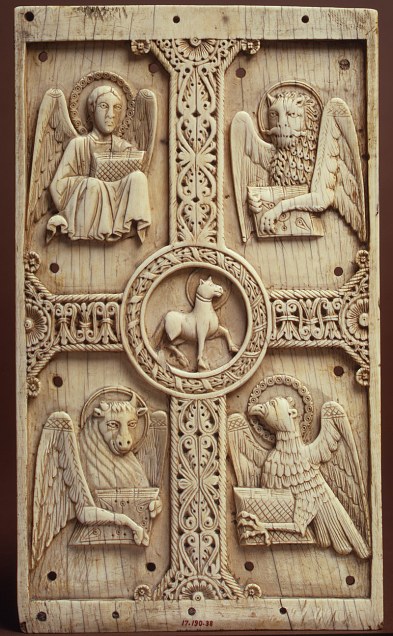I’m guessing that many of you know that the four faces from Ezekial are by tradition interpreted as symbols of the four evangelists?
But which is which? I freely admit I can never remember and when I want to know I always have to look them up (ie google them) in order to find out. I have tried to develop a mnemonic to help me remember; but the justifictions never seem very clear to me and I can’t think of a good mnemonic. For example, I just about remember how the power of John’s theology soaring like the eagle utterly convincing, but I get confused when we get onto tales of the dumb ox…is that even the right allusion? As a result I always find that the next time I try remember which one is which, I have even forgotten the mnemonic I was supposed to remember.
This version of Christ in Majesty from the Westminster Psalter is very helpful, because unlike many, the artists told us in writing which one is which. So we have John as the eagle; Mark as the Lion; Luke as the Ox and by default, Matthew as the man.
But where does this tradition come from?
Wikipedia tells us its St Jerome. But in fact, I found out in a recent scripture class, (the Old Testament in Words and Images taught by Fr Sebastian Carnazzo for the Master in Sacred Arts program at Pontifex.University) that even the Church Fathers weren’t in complete agreement.
First of all, Fr Carnazzo pointed out that the two sources don’t give identical descriptions. In Ezekial, 1:10, the description is of a single creature with four faces; while in Revelation 4:7 it is of four creatures around the throne, and the order in which they is presented is different. In Ezekial it is Man, Lion, Ox, Eagle; while in Revelation it is Lion, Ox, Man, Eagle.
And there are different interpretations as to which is which:
St Irenaeus (c. 130-200) says in Adversus Haereses (3.11.8) that it is as follows: Lion-John; Ox-Luke; Man-Matthew; Eagle-Mark
St Augustine (354-430) says in De Consensu Evangelistarum (1.6.9 and 4.10.11) that its Lion-Matthew; Ox-Luke; Man-Mark; Eagle-John.
St Victorinus (c. 280); Com. Revelation, and so St Jerome (c. 347-420) who referred to Victorinus in his Prologus quattuor Evangeliorum had it Lion-Mark, Man-Matthew, Ox-Luke; Eagle-John
While Pseudo-Athanasius Man-Matthew Ox-Mark Lion-Luke Eagle-John.
I feel better now about not being sure. And if I ever I get it wrong and am corrected, I’ll cite the Church Father who agrees with me and try to look clever!
Do wonder how long it took for the Jerome interpretation to dominate. So when we see an early depiction in which the symbolism is not made explecit, can we be sure of the artist’s intentions? This relief carving is 11th centure Italian.
When I did a version, I wrote out the names in English because I knew that people would otherwise ask me which was which, and I didn’t want to be embarrassed when I couldn’t remember the answer. I’m doubly glad I did now. I think in future I will stick to the habit.
Interesting to see that Jerome and Augustine disagreed on this as on other things. This is one interpretation in which Jerome seems to have won the battle!
Fr Sebastian Carnazzo who teaches for Pontifex University is pastor at St Elias Melkite Catholic Church in Los Gatos, CA.



I was taught the St. Augustine version. Matthew concentrates on Our Lord’s role as the Lion of Judah, or more generally on His Jewish background, so Matthew is the lion. Luke starts out with Zechariah in the Temple, where oxen were sacrificed, so Luke is an Ox. John has the soaring theology, so he is the eagle. Mark is the man, more-or-less by default, I supposed.
LikeLike